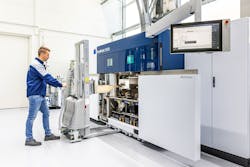Airbus Helicopters opens new 3D printing center in Germany
DONAUWORTH, Germany - Airbus Helicopters in Donauworth, Germany, announced that it has opened a new additive manufacturing - also known as 3D printing - center in Europe.
Airbus Helicopters now operates three machines for components made of titanium, four for plastic parts and, as a new element, a machine that can produce components made of aluminum. The process, also known as additive manufacturing, offers several benefits compared to conventional manufacturing. It can be used for serial production as well as for components for prototypes such as the electrically powered CityAirbus NextGen and the experimental high-speed helicopter, Racer.
"Our extensive capabilities in this process along the manufacturing chain are a real competitive advantage,” said Stefan Thomé, Managing Director of Airbus Helicopters in Germany. “Among other advantages, 3D printing can reduce the weight of aircraft components which leads to less fuel consumption. Such potential can bring financial benefits and contribute to reducing CO2 emissions during operations.”
Advantages of 3D printing include an increase in resource efficiency in the manufacturing process and high flexibility. Components with new configurations can be printed as individual pieces or in small series for testing purposes. This also makes the process appealing for building prototypes. While conventional machining involves milling components out of solid blocks, additive layer printing uses laser beams to melt metal or plastic powders. In this way, the desired shapes are created layer by layer. This makes it easier to produce complex structures than with conventional methods. A conventional manufacturing process requires up to ten times more raw material than the final product, whereas additive manufacturing requires only 1.5 times as much.
